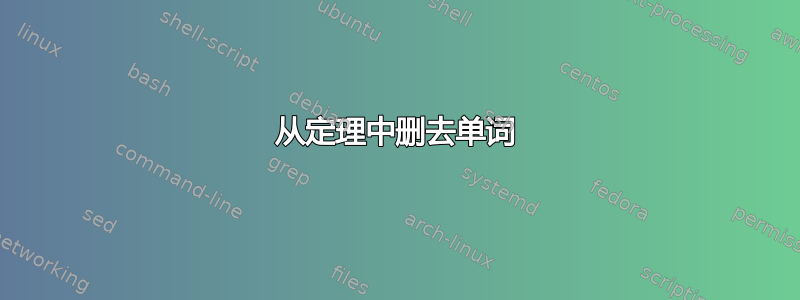
我有一个这样的定理:
\documentclass[12pt]{book}
\begin{document}
\newtheorem{definition}{Definition}[section]
\begin{definition}[Integers]
Integers are positive and negative whole numbers, including 0.\\
e.g. $..., -3, -2, -1, 0, 1, 2, 3, 4, ...$
\end{definition}
\end{document}

我怎样才能使语句“整数有正数和负数……”归结为一行?
我已尝试过 \\ 但是这会产生一行无法结束的错误并且也不会降低“整数为正数和负数...”的准确性。
谢谢你!
答案1
您可以使用amsthm和定义自己的定理样式。
\documentclass[12pt]{book}
\usepackage{amsthm,amsmath}
\newtheoremstyle{breakthm}
{\topsep}% Space above
{\topsep}% Space below
{\itshape}% Body font
{}% Indent amount (empty = no indent, \parindent = para indent)
{\bfseries}% Thm head font
{.}% Punctuation after thm head
{\newline}% Space after thm head: " " = normal interword space;
{}% Thm head spec (can be left empty, meaning `normal')
\newtheoremstyle{breakdef}
{\topsep}% Space above
{\topsep}% Space below
{\upshape}% Body font
{}% Indent amount (empty = no indent, \parindent = para indent)
{\bfseries}% Thm head font
{.}% Punctuation after thm head
{\newline}% Space after thm head: " " = normal interword space;
{}% Thm head spec (can be left empty, meaning `normal')
\theoremstyle{breakthm}
\newtheorem{theorem}{Theorem}[section]
\theoremstyle{breakdef}
\newtheorem{definition}[theorem]{Definition}
\begin{document}
\begin{definition}[Integers]
Integers are positive and negative whole numbers, including $0$,
e.g.
\[
\dots, -3, -2, -1, 0, 1, 2, 3, 4,\dotsc
\]
\end{definition}
\begin{theorem}
The integers are useful.
\end{theorem}
\end{document}

但在我看来,这只是浪费空间。
请注意,这amsthm提供了更好的自定义可能性。使用theorem(或者,更好的是ntheorem),如果您希望定义中的正文字体直立,则必须定义一种新的定理样式,这是惯例。
另一种可能性是使用thmtools,这使得定义新的定理样式变得非常容易。与之前相同的是,可以使用
\documentclass[12pt]{book}
\usepackage{amsmath,amsthm,thmtools}
\declaretheoremstyle[
postheadspace=\newline,
bodyfont=\itshape,
]{breakthm}% main style
\declaretheoremstyle[
style=breakthm,
bodyfont=\normalfont,
]{breakdef}% override the bodyfont
\declaretheorem[
name=Theorem,
style=breakthm,
numberwithin=section,
]{theorem}
\declaretheorem[
name=Definition,
style=breakdef,
numberlike=theorem,
]{definition}
\begin{document}
\begin{definition}[Integers]
Integers are positive and negative whole numbers, including $0$,
e.g.
\[
\dots, -3, -2, -1, 0, 1, 2, 3, 4,\dotsc
\]
\end{definition}
\begin{theorem}
The integers are useful.
\end{theorem}
\end{document}
答案2
有许多用于定制定理的包,包括theorem核心乳胶分布:
\documentclass[12pt]{book}
\usepackage{theorem}
\theoremstyle{break}
\newtheorem{definition}{Definition}[section]
\begin{document}
\begin{definition}[Integers]
Integers are positive and negative whole numbers, including 0.\\
e.g. $..., -3, -2, -1, 0, 1, 2, 3, 4, ...$
\end{definition}
\end{document}


